
Acropomatidae is a family of fish in the order Perciformes, commonly known as lanternbellies. Acropoma species are notable for having light-emitting organs along their undersides. They are found in all temperate and tropical oceans, usually at depths of several hundred meters. There are about 32 species in as many as 9 genera, although some authorities recognise fewer genera than Fishbase does.
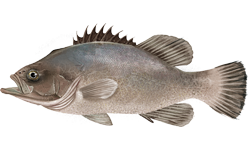
The wreckfish are a family, Polyprionidae in the suborder Percoidei of the order Perciformes.
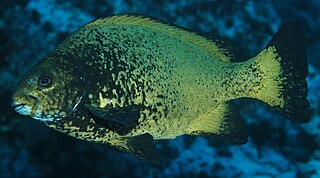
The sea chubs, also known as rudderfish and pilot fish and in Hawaiian as enenue or nenue, are a family, Kyphosidae, of fishes in the order Perciformes native to the Atlantic, Indian and Pacific Oceans usually close to shore in marine waters.
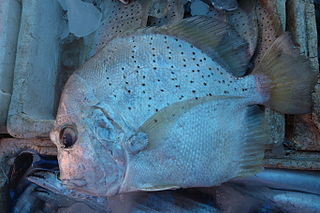
Drepane is a genus of marine and brackish water ray-finned fishes, known commonly as the sicklefishes. It is the only genus in the monotypic percomorph family Drepaneidae. These fish occur in the Indian and western Pacific Oceans, and in the eastern Atlantic near Africa.

Stichaeidae, the pricklebacks or shannies, are a family of marine ray-finned fishes in the suborder Zoarcoidei of the order Scorpaeniformes. Most species are found in the North Pacific Ocean with a few in the North Atlantic Ocean.

Forcipiger is a genus of fish in the family Chaetodontidae, the butterflyfishes. It is distributed throughout the Indo-Pacific region. The name of this genus means “bearing forceps” and is a reference to the long, slender snouts of the species in this genus.
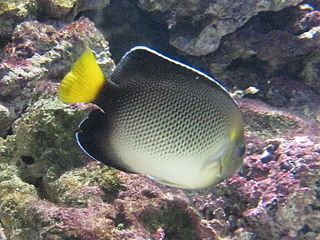
Apolemichthys is a genus of marine angelfishes in the family Pomacanthidae.
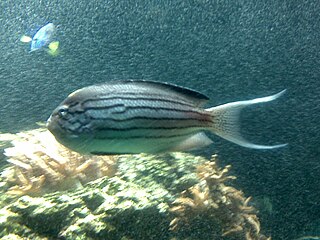
Genicanthus is a genus of marine angelfishes in the family Pomacanthidae. Known commonly as swallowtail or lyretail angelfish, these fishes are so-named for the distinctive shape of their tailfins. This genus of angels, in comparison to the other species found in hobby aquaria, are a good choice for beginners as they do not get nearly as large as some of the others. Another unique attribute is that swallowtail angels will tolerate each other and can be kept in pairs or as a single male with a harem, though it is typically best to add them to a tank at the same time. If added on by one, the angel which is added first may become aggressively territorial towards any new additions. Unlike others in the family Pomocanthidae, the angelfish species in the genus Genicanthus are generally considered to be reef safe. Also unlike most other members of the Pomacanthidae, those in Genicanthus are sexually dimorphic, meaning males and females are easily distinguishable. Fish in this species possess a small mouth relative to its size. This small mouth is well adapted for feeding on plankton in the water column. As planktivores, members of Genicanthus generally will not nip corals and sessile invertebrates.

Dermatolepis is a genus of marine ray-finned fish, groupers from the subfamily Epinephelinae, part of the family Serranidae, which also includes the anthias and sea basses. They are found in the western Atlantic, Pacific and Indian Oceans.

Conodon is a genus of grunts native to the Pacific and Atlantic coasts of the Americas. The currently recognized species in this genus are:

The banded angelfish, also known as the bandit angelfish and three spine angelfish, is a distinctive species ray-finned fish belonging to the family Pomacanthidae. It is endemic to deeper reefs in Hawaii and the Johnston Atoll.

Pomacanthus asfur, the Arabian angelfish, is a species of marine ray-finned fish, a marine angelfish belonging to the family Pomacanthidae. It is found in the Western Indian Ocean.

Pomacanthus semicirculatus, also known as the semicircled angelfish, Koran angelfish, blue angelfish, zebra angelfish or half-circled angelfish, is a species of ray-finned fish, a marine angelfish, in the family Pomacanthidae. It is found in the Indo-West Pacific Ocean. It occasionally makes its way into the aquarium trade.

Centropyge tibicen, the keyhole angelfish, black angelfish, whitespot angelfish or puller angelfish, is a species of marine ray-finned fish, a marine angelfish belonging to the family Pomacanthidae. It is found in the Indo-Pacific region.
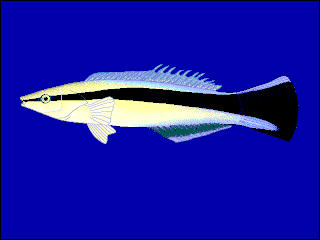
Labroides is a genus of wrasses native to the Indian and Pacific Oceans. This genus is collectively known as cleaner wrasses, and its species are cleaner fish.

Hapalogenys, the barbeled grunters or velveltchins, is a genus of marine ray-finned fish, it is the only genus in the monotypic family Hapalogenyidae, also spelled Hapalogeniidae. The species of this genus are found in depths between 30 and 230 m in coastal areas and river mouths from the shores of southern Japan to the Bay of Bengal and Northwestern Australia.

Bangana is a genus of fish in the family Cyprinidae, the carps and minnows. It is distributed across much of southern and eastern Asia. Species live mainly in the flowing waters of tropical and subtropical rivers.

Pseudocaranx is a genus of ray-finned fishes from the family Carangidae, the jacks, trevallies, scads, and pompanos. They occur in the western Atlantic Ocean and the Indo-Pacific.

The Clarion angelfish is a species of marine ray-finned fish, a marine angelfish belonging to the family Pomacanthidae. It is found in the eastern Pacific Ocean, almost exclusively near islands off the Pacific coast of Mexico.

The Clipperton angelfish is a species of marine ray-finned fish, a marine angelfish belonging to the family Pomacanthidae. It is endemic to Clipperton Island, a French possession in the eastern Pacific Ocean.



























